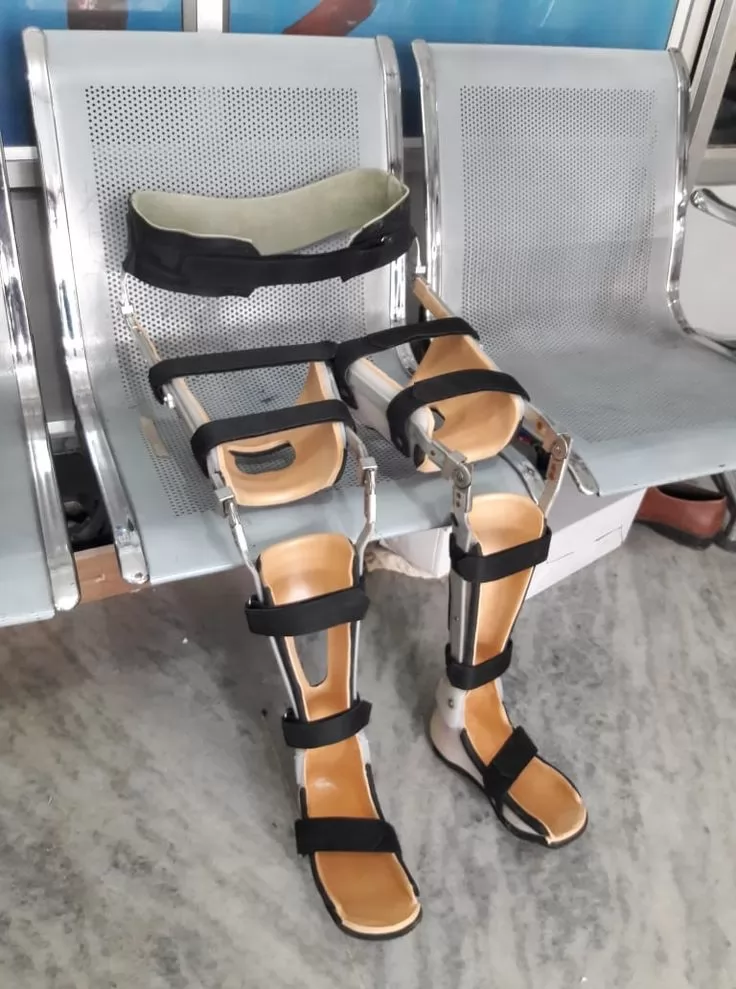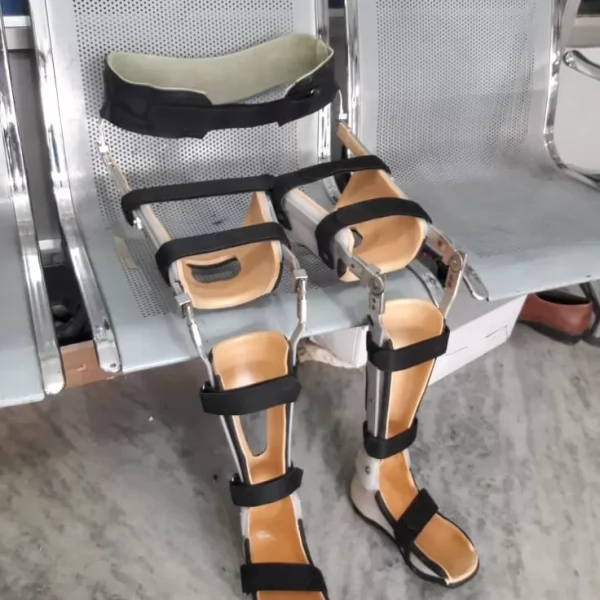Lower Extremity Orthoses
Product Categories
Lower Extremity Orthoses
LOWER EXTREMITY ORTHOSES
Lower Extremity Orthoses are devices used to correct functional loss or deformities in the lower extremity region, such as the leg, knee, ankle, foot, and hip. These orthoses are typically used after fractures, injuries, muscle weakness, nerve damage, or for protection and support to enhance movement functions.
Applications of Lower Extremity Orthoses:
Muscle Weakness and Paralysis: Individuals experiencing muscle weakness can use lower extremity orthoses to support their movements. They are especially used to correct weakened muscle parts of the leg and provide more range of motion.Bone Fractures and Amputations: After leg or ankle fractures, lower extremity orthoses are used to accelerate the healing process and ensure proper bone fusion. They can also aid in the use of prosthetics following amputation.
Postural Disorders and Deformities: Lower extremity orthoses are used for deformities such as scoliosis, leg length discrepancies, and joint misalignment, ensuring proper alignment of the limbs. They are also used for posture correction.
Nerve and Joint Disorders: In individuals with arthritis or similar conditions affecting the ankle, knee, or hip joints, lower extremity orthoses are used to alleviate pain and support movement functions.
TYPES OF LOWER EXTREMITY ORTHOSES;
INSOLE
Insoles are orthopedic devices used to provide flexible support to the foot and minimize pain. They are generally designed to correct foot alignment issues such as flatfoot (pes planus), overpronation (excessive inward rolling), and supination (excessive outward rolling). Insoles can be custom-made and shaped according to the individual's foot structure.The UCBL Insole is a special orthopedic insole used for foot structure control and weight distribution. It is used in individuals with alignment issues such as flatfoot (pes planus) or excessive pronation. UCBL insoles provide support to the arch, heel, and around the ankle. This helps the foot bones align properly and prevents pain or incorrect posture outcomes.
SUPRAMALLEOLAR
The Supramalleolar Orthosis (SMO) is an orthopedic device used to stabilize and support ankle movement, commonly preferred for individuals with pediatric foot mobility and alignment issues. This orthosis helps balance the ankle and foot, assisting with walking and posture control.Features:
- Below-knee design: The supramalleolar orthosis supports the lower leg and around the ankle.
- Foot Support: Ensures proper alignment of the foot and corrects excessive pronation (inward roll) or supination (outward roll).
- Lightweight and Flexible: SMOs are usually made from lightweight and flexible materials, providing stability without significantly limiting the user's mobility.
AFO
Ankle-Foot Orthoses (AFOs) are orthopedic devices used to stabilize the ankle and foot and control movement. These orthoses correct ankle misalignment, support proper gait, and are used to relieve problems caused by certain muscle and nerve disorders.Structure and Types of AFO:
AFOs are usually made from plastic, carbon fiber, or composites, allowing patients to carry out daily activities more comfortably and independently.
Structural Features:
An AFO has a frame that stabilizes the ankle and foot. It starts below the knee and wraps around the foot sole. They can be designed as rigid, semi-rigid, or flexible. Carbon fiber AFOs are preferred by athletes and active individuals due to their lightweight and durable structure.
Types of AFO:
- Rigid AFO: Provides full support and limits movement.
- Dynamic AFO (DAFO): Offers controlled movement for more natural walking.
- Soft AFO: Offers mild support with a flexible and comfortable design, typically used for less restrictive needs.
- Adjustable AFO (ARTICULATED): Articulated AFO features hinges or joint systems that allow controlled ankle-foot motion. It permits ankle dorsiflexion while maintaining stability, allowing for a more natural gait. It's also useful for conditions like cerebral palsy and can be customized.
- LEAF SPRING AFO: This type of AFO, usually thin and flexible, supports the ankle. It gets its name from its leaf-like shape and provides flexibility and movement during walking. It is particularly beneficial for foot drop and assists in lifting the foot naturally while stepping. Its light structure makes it comfortable for daily use.
- CARBON AFO: A carbon fiber-reinforced orthosis that is lightweight and durable. Ideal for athletes and active individuals, it provides sufficient support without restricting motion. Offers energy return for more natural movement during walking and running. Popular due to its lightweight, comfort, and aesthetic look, though it is more costly than other types.
- WALKING AFO: The Walking AFO is a special type of orthosis designed to ensure proper alignment of the ankle and foot and help the user achieve a more natural gait pattern. It is used by individuals with conditions like foot drop. It improves mobility and balance for everyday use.
- RESTING AFO: The Resting AFO is an orthopedic device used to keep the ankle and foot stable during rest. It is often used during the recovery process, especially for treating pain, inflammation, or sports injuries. By holding the ankle in position, it helps prevent unnecessary movements and aids healing.
KAFO:
KAFO (Knee-Ankle-Foot Orthosis) is a type of orthosis used to support the knee, ankle, and foot, stabilizing the lower extremity. It is typically used for individuals experiencing weakness due to muscle loss, injury, or trauma. This orthosis limits natural motion at the knee, ankle, and foot to improve balance and assist with walking.Features:
- Knee, Ankle, and Foot Support: KAFO provides stabilization for all three, playing an important role in conditions like polio, MS (Multiple Sclerosis), or cerebral palsy.
- Heavy Load Support: Provides strong walking support for weak muscles.
- Customizable: Can be tailored to the user's needs. For example, adding joints to restrict or allow more knee flexion.
- Applications:
- Muscle Weakness: For individuals needing knee or ankle support due to conditions such as cerebral palsy, stroke, MS.
- Knee Stability: For individuals requiring knee support due to injuries or weak muscles.
- KAFO is especially important for individuals seeking regular ambulation or increased independence in daily life.
HKAFO
HKAFO (Hip-Knee-Ankle-Foot Orthosis) is a comprehensive type of orthosis that supports the hip, knee, ankle, and foot areas. It is used by individuals with limited mobility due to muscle weakness or conditions like cerebral palsy or stroke. HKAFO provides the necessary support to stabilize the lower extremities, allowing the individual to walk more safely and maintain balance.Features:
- Hip Support: Provides complete support for the hip, knee, ankle, and foot regions.
- Leg Mobility and Function: Includes hinge systems that limit knee flexion and control ankle movement, helping the person walk properly and with balance.
- Heavy Support: Built with a very sturdy and stable structure to provide muscle and joint support.
- Applications:
- Muscle Weakness: For conditions involving hip and knee muscle weakness, spinal injuries, cerebral palsy.
- Paralysis: Used for individuals with lower extremity movement issues, particularly to provide support after neurological events.
- Rehabilitation: Used during recovery processes to support walking function.
HKAFO provides great benefit especially for individuals with low muscle strength, encouraging independence and preserving joint mobility.


